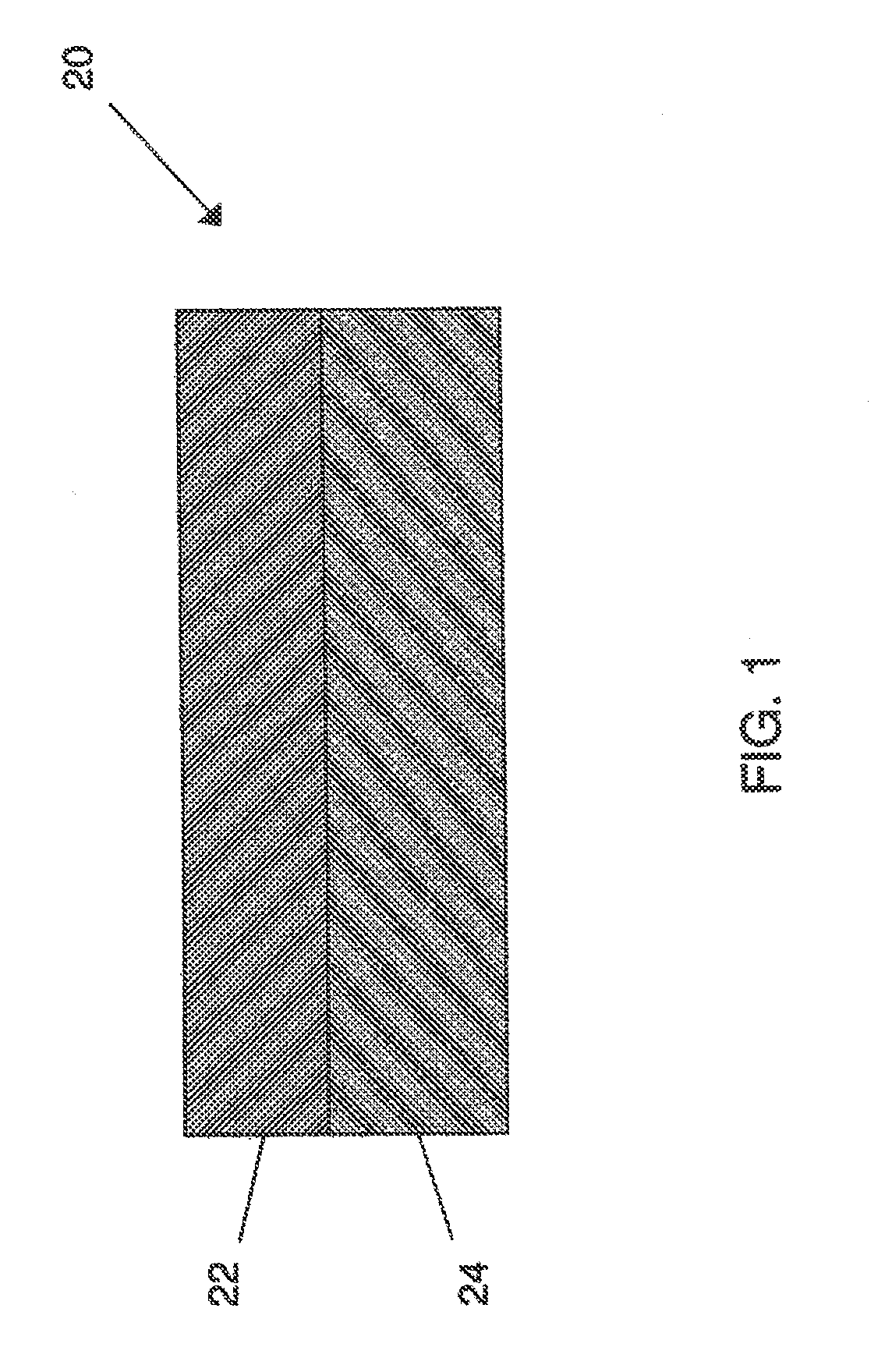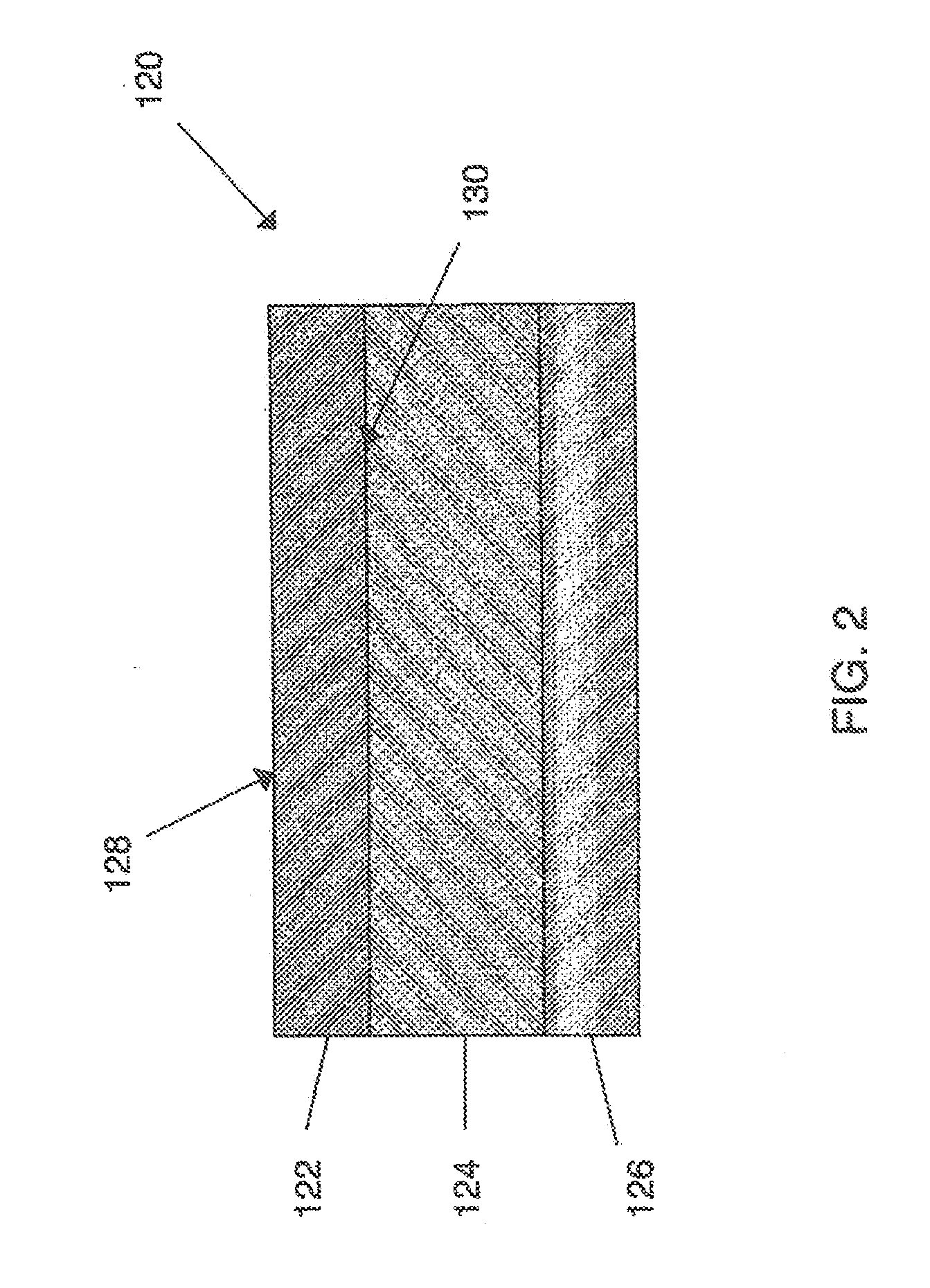[0009]In accordance with a first aspect, a mono-layer film is comprised of a material or mixture of materials having a total bio-based content of about 10% to about 100% using ASTM D6866-10, method B. The film layer has a thickness of from about 1 μm to about 750 μm and is at least partially formed from a polymer (A). In one embodiment, the film layer has a thickness of from about 1 μm to about 200 μm. The film layer comprises from about 75% to about 99% by weight of a polymer (A). The polymer (A) comprises at least one or possibly more of a low density polyethylene (LDPE), a polar copolymer of polyethylene such as ethylene vinyl acetate (EVA), a linear low density polyethylene (LLDPE), a high density homopolyethylene/high density polyethylene copolymer, a medium density polyethylene, a very low density polyethylene (VLDPE), a plastomer, a polypropylene/copolypropylene/heterophasic polypropylene, polyethylene terephthalate (PET), PLA (e.g., from Natureworks), polyhydroxyalkanoate (PHA), poly(ethylene-2,5-furandicarboxylate) (PEF), cellulose (available from, for example, Innovia), NYLON 11 (i.e., Rilsan® from Arkema), bio-polyesters, (e.g., those made from bio-glycerol, organic acid, and anhydride, as described in U.S. Patent Application No. 2008/0200591, incorporated herein by reference), polybutylene succinate, polyglycolic acid (PGA), and polyvinyl chloride (PVC). At least one of the constituents of polymer (A) is at least partially derived from a renewable resource.
[0010]In accordance with a second aspect, a laminate bi-layer film comprises a first film layer and a second film layer, wherein the bi-layer film has a bio-based content of about 10% to about 100% using ASTM D6866-10, method B. The first and second film layers are produced in independent steps and adhesively laminated together or the second film layer is coated onto the first film layer via extrusion coating, solvent coating, etc. Each of the two film layers has a thickness of from about 1 μm to about 750 μm and each is at least partially formed from a polymer (A). In one embodiment, each of the two film layers has a thickness of from about 1 μm to about 200 μm. When adhesively laminated, the tie layer has a thickness of about 1 μm to about 20 μm. Each of the two film layers comprises from about 75% to about 99% by weight of a polymer (A). The polymer (A) can be compositionally different in each of the two layers and comprises at least one or possibly more of a low density polyethylene (LDPE), a polar copolymer of polyethylene, a linear low density polyethylene (LLDPE), a high density homopolyethylene/high density polyethylene copolymer, a medium density polyethylene, a very low density polyethylene (VLDPE), a plastomer, a polypropylene/copolypropylene/heterophasic polypropylene, a nylon, a polyethyelenegterephthalate (PET), PLA (e.g., from Natureworks), polyhydroxyalkanoate (PHA), poly(ethylene-2,5-furandicarboxylate) (PEF), cellulose (available from, for example, Innovia), NYLON 11 (i.e., Rilsan® from Arkema), bio-polyesters, (e.g., those made from bio-glycerol, organic acid, and anhydride, as described in U.S. Patent Application No. 2008/0200591, incorporated herein by reference), polybutylene succinate, polyglycolic acid (PGA), and polyvinyl chloride (PVC). At east one of the constituents of polymer (A) is at least pary derived from a renewable resource.
[0011]In accordance with a third aspect, a laminant tri-layer film comprises a first film layer, a second film layer, and a third film layer with the first film layer disposed on one surface of the second film layer and the third film layer disposed on the other surface of the second film layer, wherein the tri-layer film has a bio-based content of about 10% to about 100% using ASTM D6866-10, method B. The first, second, and third film layers are produced in independent steps and adhesively laminated together or the first and third film layers are coated onto the second film layer via extrusion coating, solvent coating, etc. Each of the three film layers has a thickness of about 1 μm to about 750 μm and each is at least partially formed from a polymer (A). In one embodiment, each of the three film layers has a thickness of from about 1 μm to about 200 μm. When adhesively laminated, each tie layer has a thickness of about 1 μm to about 20 μm. Each of the three film layers comprises from about 75% to about 99% by weight of a polymer (A). The polymer (A) can be compositionally different in each of the three layers and comprises at least one or possibly more of a low density polyethylene (LDPE), a polar copolymer of polyethylene, a linear low density polyethylene (LLDPE), a high density homopolyethylene/high density polyethylene copolymer, a medium density polyethylene, a very low density polyethylene (VLDPE), a plastomer, a polypropylene/copolypropylene/heterophasic polypropylene, a nylon, a polyethyeleneterephthalate (PET), PLA (e.g., from Natureworks), polyhydroxyalkanoate (PHA), poly(ethylene-2,5-furandicarboxylate) (PEF), cellulose (available from, for example, Innovia), NYLON 11 (i.e., Rilsan® from...
 Login to View More
Login to View More 


